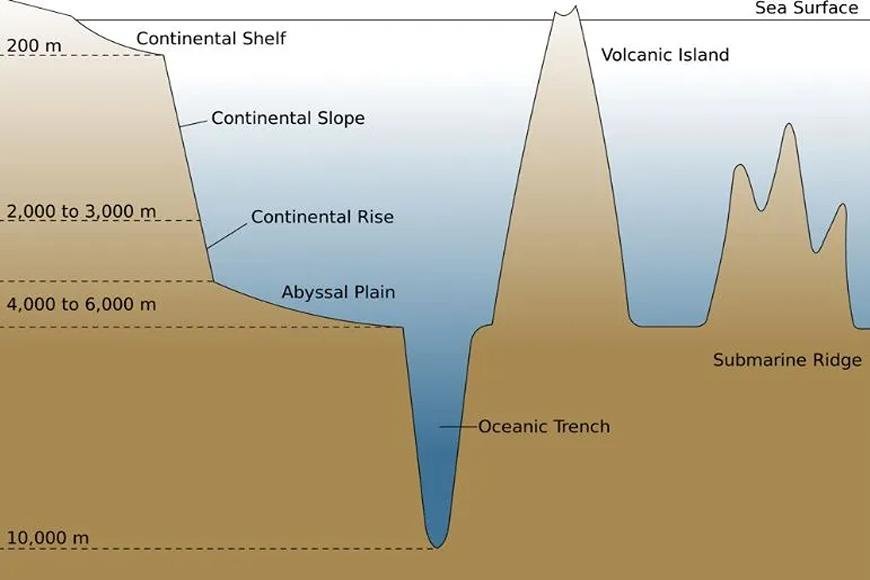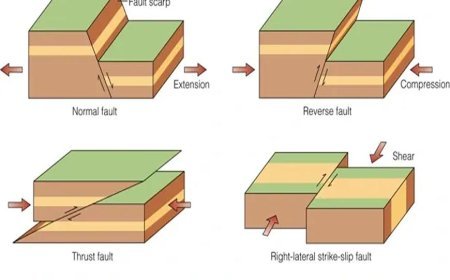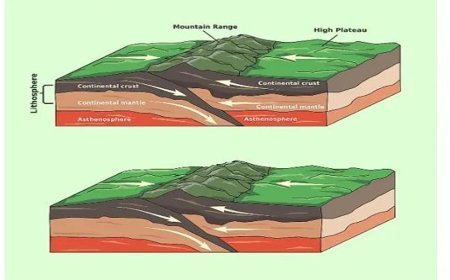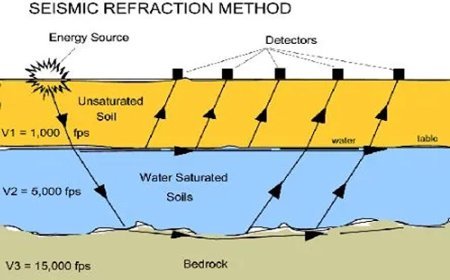OCEAN TRENCH
Ocean Trenches: Earth's Deepest Scars! Tectonic plates collide, plunging rock into the mantle.

OCEAN TRENCH
- The oceans cover around 72 percent of the Earth's surface.
- It has always contributed to the Earth's dynamically changing face through tectonic phenomena happening at its depths.
- The oceanic trench is the name given to such a naturally occurring phenomenon.
- The Pacific 'Ring of Fire' is a horseshoe-shaped, 25,000-mile ring that surrounds the Pacific and contains around three-fourths of the world's volcanoes.
- There are thought to be an infinite number of oceanic trenches surrounding it, including 17 of the 20 main trenches found so far.
- The Earth is made up of numerous layers or spheres that are concentric to a molten core.
- The lithosphere is the earth's top layer or crust.
- It floats above the asthenosphere and is stiff.
- The lithosphere is made up of a collection of tectonic plates that are constantly moving relative to one another. Plate motion results in several topological aspects on Earth.
- The ocean trench is one of many structures found under the sea.
- Ocean trenches are small V-shaped depressions that extend across considerable distances in the active parts of ocean basins.
- Submarine valleys are another name for them.
- They are quite similar to deep ravines seen on Earth's surface.
- The 'hadal zone,' named after the Greek underworld deity 'Hades,' consists of 50,000 km (31,000 mi) of convergent plate boundaries on the Earth's oceanic crust.
- The majority of them are found in the Pacific Ocean, although others are found in and around the Indian Ocean, as well as the Atlantic and Mediterranean Sea edges.
- The climatic conditions at such depths as ocean trenches are exceedingly harsh.
- The pressure in the tunnels can reach 1,000 times that on the surface.
- There is practically no light reaching that level, and it is pitch black down in the trench chasms. It is known that the temperature in the trenches is somewhat higher than the freezing point of water.
Subduction Zone
- Subduction is the geophysical process by which one of the Earth's tectonic plates moves beneath the other.
- The origin of mid-ocean ridges may be traced back to the genesis of a subduction zone.
- These mid-ocean ridges are a group of underwater volcanic hills.
- The flowing mantle material from these mid-ocean ridges is what creates the new oceanic crust.
- As these freshly produced crusts travel away from the ridges, they begin to spread and cool on the ocean floor.
- As the cooled oceanic crust begins to shrink, it becomes denser and heavier.
- When this crust meets another oceanic or continental crust, gravity causes the heavier crust to melt and slide (subduct) beneath the lighter crust.
- The heavier plate sinks or merges with the mantle. A dip forms along the plates' converging ridge. These depressions are referred to as oceanic trenches.
Formation of the Oceanic Trench
- Subduction zones and the activities that result from them are the main causes of oceanic trenches.
- The movement of the Earth's crust along tectonic plate convergent borders, whether oceanic crust and continental crust or two oceanic crusts, results in a steep, deep valley with the two crusts acting as its walls.
- The continental crust is usually heavier than the oceanic crust.
- The slope of the heavier crust is moderate, but the slope of the lighter crust, which forms the inner wall, is severe.
- Every year, the oceanic crust disappears into the trenches at a pace estimated to be one-tenth of a square meter every second.
- Trenches cause a variety of natural phenomena, such as mountain ranges, earthquakes, and volcanic arcs.
- These upcoming occurrences are the result of an increase in mantle material due to the melting of ocean bottom subduction.
- The molten material then rises above the crust in volcanic chains parallel to and surrounding the trench.
- Continental shelves or volcanic belts, are present within 200 kilometers of an oceanic trench and are used to locate it.
- As the Pacific Plate subducts beneath the North American Plate, the Aleutian Arc forms.
What's Your Reaction?



































